QUAKER CAMPUS
Oct. 16, 2025

Oct. 16, 2025
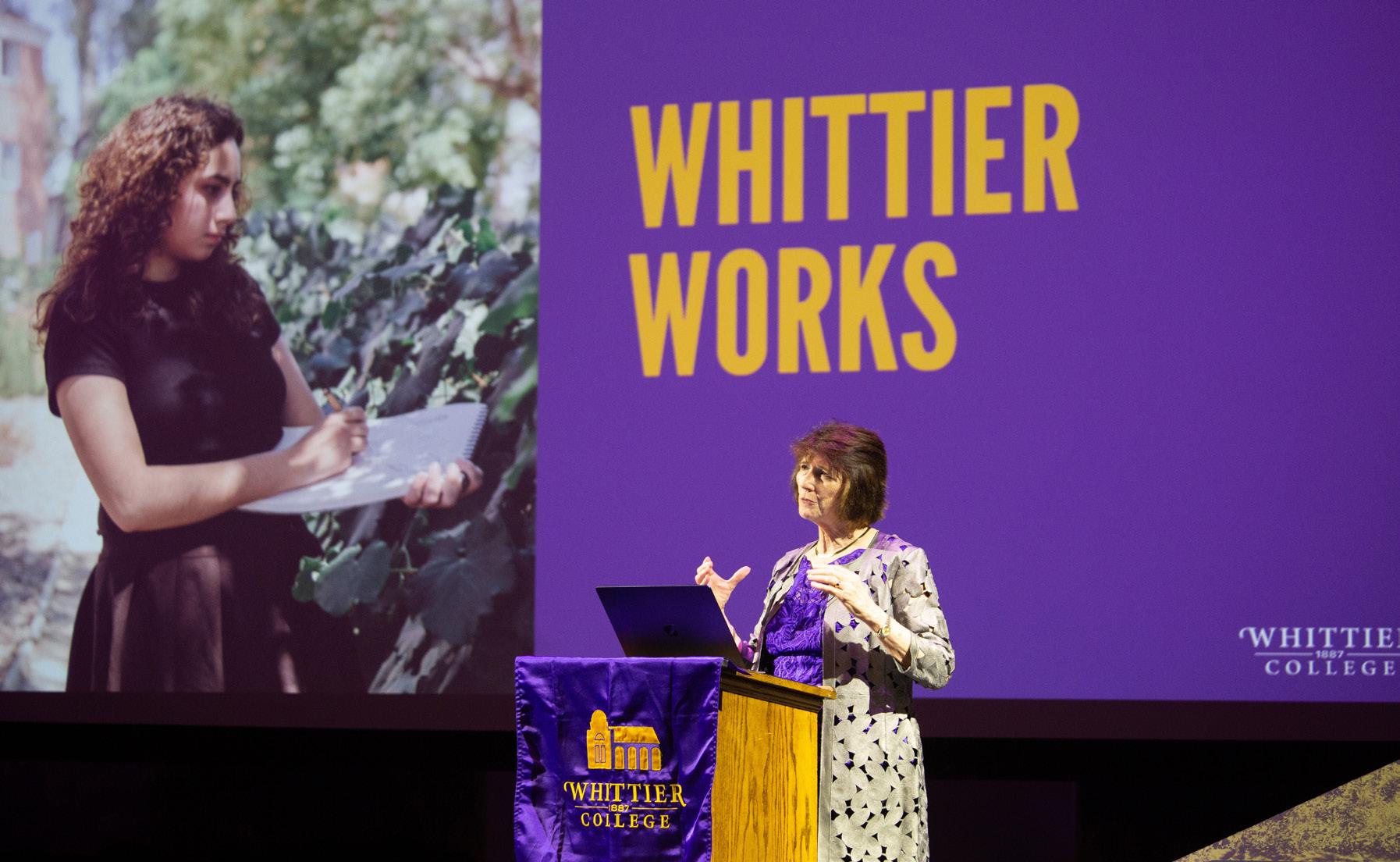
On Friday, Oct. 10, the President of Whittier College, Kristine Dillon, delivered her State of the College Address. The Ruth B. Shannon Center was packed with alumni, donors, and current students, all waiting to hear about the future of the College. Dillon discussed a wide range of important topics, including enrollment, financial aid, key initiatives, renovations, athletics, and professional development opportunities for students.
Despite their past financial difficulties, the College has been making substantial and progressive strides, aiming to create both short-term and long-term stability.
Dillon shares the three short-term key initiatives that are currently being prioritized by the College: reviewing and strengthening plans for recruitment and financial aid, launching targeted fundraising campaigns, and completing an audit of organizational efficacy and efficiencies. These efforts are well underway; their impact is already visible through the changes happening across campus.
The College’s new recruitment plans have already proven successful. Dillon expresses her pride in the College’s enrollment rates, which have been steadily
growing over the past three years while other institutions are experiencing a decline. Enrollment rates have increased by a staggering 20 percent since Fall 2024 and 55 percent since Fall 2023. President Dillon believes this growth is partly due to Whittier College’s increased initiatives to appeal to prospective students in the greater Whittier area, something that was previously not prioritized. Dillon discusses how Whittier College prides itself on the fact that 100 percent of students receive financial aid from the College, most commonly in the form of individual grants and the John Greenleaf Whittier Scholarship Program. Dillon spent the majority of the address expressing
initiative exceeded its goal by 116 percent, with 2,344 donors in total, 1,500 of whom were alumni. Fundraising efforts have been crucial to the future of athletics on campus, especially the return of Football and Men’s Lacrosse, being due to these donations. Notably, alumnus Jonathan Damm led the fundraising campaign to bring men’s lacrosse back, raising over $180,000. At this event, Damm received the Poet Impact Award, recognizing his efforts in making the broader Poet community believe that fundraising for athletics was really possible. The George Allen Fitness Center (GAC) is currently being renovated, and the update to the football locker room has already been completed. This
"This is a way for us to show that Liberal Arts leads to great career opportunities for graduates."
- President Kristine Dillon
gratitude to the alumni, trustees, and supporters whose donations and fundraising efforts have made the College’s grants, growth, and initiatives possible. The College successfully raised $7.9 million during the 24-25 academic year.
did put emphasis on the College’s shift of focus towards what she called “Community Engagement Professional Development Internships.” Experiential learning opportunities are essential in preparing Whittier students to enter the workforce after guiding them towards graduation. Dillon wants the College to be a place where students can apply to internships or programs where they can learn and strengthen career specific skills. Whittier Works is a program committed to providing students with professional career experience through internships and scholarships. In regard to this program, Dillon explains, “This is a way for us to show that Liberal Arts leads to great career opportunities for graduates.” The opportunities offered through Whittier Works are intended to make Whittier graduates strong and desired candidates in their future endeavors.
• On Tuesday, Oct. 14, U.S. President Donald Trump threatened Argentina with cutting their financial aid if the current Argentinian President Javier Milei loses legislative elections on Oct. 26. According to The Guardian, “Trump’s administration has already promised $20 billion to prop up Argentina’s struggling economy…”
• On Oct. 14, the President of Madagascar, Andry Rajoelina, was removed from office during a military coup. Before the coup, there were weeks of youth protests over poverty, power outages and a lack of opportunity in the country, reports AP News
• On Oct. 14, the New York Times stated, “Russia’s main intelligence agency on Tuesday (Oct. 14) announced a sweeping terrorism investigation into nearly two dozen antiwar Russians.” As of now, Russia is targeting the Federal Security Services (F.S.B.) because of their suspected plotting to overthrow the government.
The Whittier Now! fundraising renovation was completely donorfunded, showing the dedication and generosity of Whittier’s alumni and supporters.
Another big change soon to come is a new curriculum. Although President Dillon did not talk about the curriculum itself in detail, she
Beyond this program, there are a wide variety of careerspecific fellowship and research opportunities now being offered at the College, such as the Whittier College Coffee Initiative, the Civil Scholars Program, and the Peer Health Education Program. Whittier College offers 25 on-campus internships, partners with 40+ corporations, and provides the students the chance to earn eight summer internships in China with the tech company INTEX. Whittier students have a huge amount of career-building opportunities available that they will benefit in taking advantage of. By making significant progress in meeting its short-term goals, the College is also steadily working towards satisfying its long-term objectives. Dillon outlined what she referred to as the “Six Pillars” towards long-term financial stability: rebuilding enrollment, elevating fundraising, diversifying revenues, managing expenditures, pursuing strategic collaborations, and enhancing financial flexibility. As more initiatives are put into place, students will steadily see more changes happening campuswide. President Dillon’s address painted a bright future of the College thanks to new objectives and the help of donors.
Evan Josten FOR THE QC
On Nov. 4, a special election will be on California’s ballot. It was presented by California Governor Gavin Newsom, who claims that: “Californians have been uniquely targeted by the Trump Administration, and we are not
going to sit idle while they command Texas and other states to rig the next election to keep power.”
This Proposition is presented to explicitly prevent President Donald Trump and his allies from having a dominating majority in Congress. If Congress is overrun by MAGA Republicans, Trump will have no barriers to passing legislation.
Although California is a longstanding Democratic majority state, some voters are concerned that this effort is unjust and undermines democracy, as the redistricting will create more Democratic districts in California. However, this proposition intends to “nullify” Texas’s efforts to create a Republican House of Representatives.
The redrawing of district boundaries within states has been largely divisive for decades, while remaining unresolved. Newsom aims to utilize the strategic redistricting used in red states like Texas to attack Trump’s ability to control Congress.
Continued on pg. 2
• On Monday, Oct. 13, Venezuela announced they would close their embassy in Norway after their opposition leader Maria Corina Machado was awarded a Nobel Peace Prize. Machado was awarded this prize because of her effort and “her tireless work promoting democratic rights,” says the New York Times. Venezuela’s Foreign Ministry will relocate their resources to focus on establishing alliances with the Global South. They will also close an embassy in Australia and open new ones in Zimbabwe and Burkina Faso.
• On Saturday Oct. 11, Ukrainian President Volodymyr Zelenskyy urged U.S. President Donald Trump “to use the momentum of the Gaza ceasefire to broker peace in Ukraine,” according to The Guardian. The two presidents discussed Ukraine’s request for the U.S. to allow cruise missiles that would allow long-range strikes inside of Russia.

Prop. 50 Cont. from pg. 1
While it can differ from stateto-state, legislators have the power to redraw the boundaries of the districts which are governed by their Congressional representatives. Every congressional district is purported to have approximately the same population. President Trump and Governor Newsom alike are “gerrymandering” with opposing goals.
They are manipulating the boundaries of the districts in order to benefit their political goals. This can take the form of packing all voters of one particular party into one district, limiting the amount of representatives they have.
Legislators might also want to split “crack” districts in two, splitting communities that historically vote in one direction so that those communities no longer have a majority in the two new districts.
Gerrymandering as a practice is controversial, often cited as inaccurately representing a state’s constituents by drawing borders based on community identity and voting behavior, as opposed to veritable geographic or cultural lines.
If Prop. 50 is voted into law, the proposal will allow the California state legislature to redraw district maps that will stand until the 2030 Census. Governor Newsom is receiving financial support for the proposition from The Fund for Policy Reform, House Majority PAC, and labor unions like the
a right,” claiming Governor Newsom is attempting to combat Trump by “becom[ing] him.”
On Oct. 10, students of Whittier College were surveyed regarding Prop. 50. The survey, conducted by the Quaker Campus, aimed to gather information on students' thoughts on the
“It sounds like an okay way to counteract a similar situation happening the other way around in states like Texas.”
National Education Association and California Nurses Association. If Prop. 50 does not pass, California will maintain its existing congressional districts; they will stand as they have been since they were redrawn in 2011. Prop. 50 is opposed by the Republican Party, as they are expected to lose their House majority if California’s districts are redrawn. Former Californian Governor Arnold Schwarzenegger expressed that voting yes on Prop. 50 is undemocratic. Schwarzenegger argues “Two wrongs don’t make
proposition and whether they expect to vote in the upcoming election. In the survey, 60 percent of students identify as left-leaning, 20 percent as centrist, and 20 percent as strongly left. 60 percent identify as women and 40 percent as men, with all respondents identified as Hispanic/Latino and 10 percent also identified as Native American.
All the students shared that they will be voting “Yes” on the proposition. One student who identifies as a Hispanic/ Latino man shares, “[Voting yes] is something I feel I can do to
EDITOR-IN-CHIEF Paige Meyer-Draffen
DePUTy eDiTOr eMMa galvan
Managing eDiTOr
PenelOPe TUrgen
neWS eDiTOr
PaOla rUiz
OPiniOnS eDiTOr
angelica HenneSSy
SPOrTS eDiTOrS
aTTicUS cHaiDez
MOnze Meraz-lerMa
caMPUS life
eDiTOr
naDia Miller
FEATURES EDITOR
eMMa cianciOla
a&e eDiTOr eliaS lOya
HeaD cOPy eDiTOr clOver MOraleS
SOcial MeDia MOnze Meraz-lerMa
STaff WriTerS
allara Baker
eTHan raMillanO
MaDySOn eScOBeDO
OSWen MarTinez
Mickey rHODUS
JayDen garreT
JayDen BOrgna
XOcHiTl HOOD
cOPy eDiTOr eTHan ariaDa
graPHic
DeSigner naDia Miller
carTOOniST neMi DOc
facUlTy aDviSOr
JOSePH DOnnelly
contribute to combating Trump's agenda.” Another student who identifies as a Hispanic/Latino woman remarks, “It sounds like an okay way to counteract a similar situation happening the other way around in states like Texas."
Republicans and others have argued that Prop. 50 directly goes against the 2008 CA Proposition that established the Citizens Redistricting Commission: a nonpartisan group of Californian citizens who organize redistricting with the decennial Census.
While Prop 50 does allow for gerrymandering until 2030—the next Census—Gavin Newsom argues against fears voiced by California voters, attesting: "this is a fight to save democracy from President Trump and MAGA Republicans." He asserts, “We are not going to sit idle while they command Texas and other states to rig the next election to keep power.” He adds that Prop. 50 “would give Californians a choice to fight back—and bring much-needed accountability and oversight to the Trump Administration.”
There are also concerns that this redistricting will divide communities further in a time of great political polarization. However, a nonpartisan analysis of
the proposed redistricting found this effect to be negligible and therefore addressed some voters’ concerns.
Prop. 50 has serious implications for the 2026 midterm Congressional elections. If passed, it would increase the number of Democrats in the House of Representatives, allowing for better majority representation and real pushback on Trump’s ongoing agenda in turn. In the case this proposition does not pass, congressional districts will remain for the 2026 election, and the number of Republicans in the House would likely increase as outlined by Trump and Texas Governor Greg Abbot’s redistricting efforts. The election will take place on Nov. 4, and every California voter will receive a ballot in the mail. Ballots will be sent to Californian counties starting on Oct. 6. To be able to vote, one must be a permanent resident of California, a citizen of the United States, and be registered to vote. Mail-in ballots must be signed and sent by election day. Voters can go to the polls to vote in person in their county of residence on Nov. 4 from 7:00 a.m. to 8:00 p.m. Your vote matters; make it count.
Submissions may be emailed to qc@poets.whitttier.edu in .doc or .docx format. Submissions must include the author’s name and year of graduation or position at the college in the signature. Letters are due by Monday at 5 p.m. to make it into that week’s issue. Submissions should be no more than 500 words. Submissions will undergo the same editing process from our production pipeline if selected. All stories must follow the same journalistic standards.
Due to the high cost of publication, members of the Whittier College community are permitted three copies per issue. Additional copies may be purchased with prior apporval for 50 cents each by contacting the Quaker Campus. Newspaper theft is a crime, and those who violate the three copy rule may be subject to civil and criminal prosecution.
The Quaker Campus does not change material posted on online articles once they have been published in the paper — with the exception of an error being found. Only then will a correction be made to the online version. The Quaker Campus is a publication of Whittier College. Columns and Signed editorials do not necessarily reflect the opinions of Whittier College or its affiliates.

On Oct. 1, at 12:01 a.m., the U.S. government was shut down after Congress was unsuccessful in passing a funding budget before the start of the new fiscal year.
Senate Republicans, who hold a majority but do not have the 60 votes required to overcome a filibuster, have been unable to push through a shortterm funding resolution without Democratic support. This leaves thousands of federal workers without pay and essential services operating with limited staff.
To pass the federal budget, the Republican-dominated Congress needs “at least five Senate Democrats to break ranks and do the right thing for the American people,” explains House Speaker Mike Johnson. So far, three Democratic Senators have sided with the Grand Old Party (GOP) on procedural votes, leaving the government at a standstill.
The central issue dividing the two parties is the extension of the Affordable Care Act (ACA) premium subsidies, which are set to expire by the end of 2025.
Senate Democrats have refused to vote for the current proposed budget because it will not go against the policies of the ACA and argue that millions of Americans could see their insurance costs spike in private and government insurance.
“We will not trade away people’s healthcare coverage just to reopen the government for a few weeks,” says Arizona Senator Mark Kelly, who has been vocal in demanding that these subsidies be included.
Republicans, meanwhile, are accusing Democrats of using the shutdown to push for changes in the ACA to benefit their party, during the budget votes.
“They are holding the government hostage for political leverage,” asserts South Dakota Senator John Thune, who has led the GOP strategy of waiting for Democrats to accept the new budget.
As the shutdown drags into mid-October, The Guardian
reports that both parties are "digging in their heels,” with neither side willing to take the political risk of compromise.
Without the Democratic votes needed and Republicans waiting out the Democrats, the Senate remains in a deadlock, and reopening the government has grown increasingly uncertain.
Every major federal department has been struck by the funding lapse, forcing agencies to cut workers, delay programs, or suspend public services.
The Department of Education, which manages federal student aid, has been cutting most of its workforce.
While core functions such as the Pell Grant and loan disbursements continue, officials warn that “processing times for aid verification, FAFSA updates,
food-security programs, while the Department of Transportation (DOT) has postponed infrastructure grants and safety inspections.
Although air-traffic controllers and TSA officers remain hard at work, unions caution that sustained staffing shortages could lead to nationwide delays.
Other agencies like the Environmental Protection Agency (EPA), Department of Energy, and Housing and Urban Development (HUD, have halted environmental reviews, energyefficiency programs, and housing grants.
The federal shutdown may feel distant to many students, but its effects ripple into everyday life.
For Whittier College, where many students rely on the Pell Grant, loans, and work-study, even short delays can generate anxiety.
“We will not trade away people’s healthcare coverage just to reopen the government for a few weeks,”
- Arizona Senator Mark Kelly
and compliance inquiries could slow down significantly,” according to AP News.
The Department of Health and Human Services (HHS) has also paused many grant-review activities through its agencies, such as the National Institute of Health (NIH) and Centers for Disease Control and Prevention (CDC), leaving public health research and clinical trials on pause, states The Washington Post.
The Department of Commerce, under its umbrella, key statistical agencies such as the Census Bureau and the Bureau of Economic Analysis have been forced to delay monthly economic reports.
Economists warn that missing data “creates uncertainty for policy-making and higher education planning,” particularly for schools that rely on national statistics.
The Department of Agriculture (USDA) has slowed nutrition and
The Department of Education has stated it can continue core aid functions temporarily, but prolonged shutdowns can disrupt verification or freeze disbursements.
The uncertainty also extends to research and faculty funding. Any projects tied to NIH, HHS, or EPA grants could experience payment delays or postponed review cycles.
That affects not only faculty projects but also student assistants who depend on those grants for stipends or research credit.
For international students, the closure of some U.S. Citizenship and Immigration Services (USCIS) offices have delayed visa processing and work-authorization renewals.
Campus departments that rely on federal data like institutional research, economics, or publicpolicy programs, are also feeling the pinch as the Census Bureau and Bureau of Labor Statistics suspend regular updates.
Beyond our campus, Los Angeles County could see compounding effects through local grants and community
partnerships tied to federal housing, transportation, and even environmental programs.
Many local nonprofits, some of which collaborate with Whittier students through service learning, depend on those funds.
The U.S. Senate is expected to vote again on a temporary funding plan in mid-October, but both sides remain entrenched. Republicans insist that reopening should come first, while Democrats maintain that any deal must include the proper health care funding and social program protections.
As the shutdown continues and is nearing the 35-day record set in 2019, there are worries that it may threaten to surpass it.
Economists warn that repeated shutdowns erode public trust, slow growth, and disrupt higher-education budgets.
For Whittier College and educational institutions nationwide, this political impasse is more than a headline; it is a direct reminder that the gridlocks by the U.S. Congress can affect the daily lives of students, faculty, and the communities they serve.

Stay up to date on events! For further info, visit https://whittier. campuslabs.com/Engage/
Great Shakeout
• Thursday, Oct. 16 at 10:16 a.m.
• Whittier College
Palestine in Context Lunch Series: Critical Conversations
• Thursday, Oct. 16 at 12:30 p.m.
• Campus Inn (CI)
Poet Pantry
• Thursday, Oct. 16 at 12:30 p.m.
• Campus Center Room 141
Meet a Mate to CheckMate!
• Thursday, Oct. 16 at 6:00 p.m.
• Upper Quad
National College Health Assessment (NCHA Survey)
• Thursday, Oct. 16 at 12:00 p.m.
• Online
SLEEPING BEAUTY directed by Katie Liddicoat
• Friday, Oct. 17 at 12:00 p.m.
• Ruth B. Shannon Center
Fall Movie Night
• Friday, Oct. 17 at 8:00 p.m.
• Stauffer Lounge
Bug Club Meeting!
• Monday, Oct. 20 at 12:30 p.m.
• Campus Courtyard Lower Level
MEChA Weekly Meeting
• Monday, Oct. 20 at 4:30 p.m.
• Ortiz Lounge
Transfer Week Day 1: Boba Giveaway
• Tuesday, Oct. 21 at 12:00 p.m.
• Outside the front of the SLC
Sustainability Club Bi-Weelky Meeting
• Tuesday, Oct. 21 at 12:30 p.m.
• Founder's Hill
First Generation & Allies Weekly Meeting
• Tuesday, Oct. 21 at 12:30 p.m.
• Platner 201
Psychology Club's First Meeting
• Wednesday, Oct. 22 at 4:00 p.m.
• SLC 309
Transfer Week Day 2: Paint the Rock
• Wednesday, Oct. 22 at 4:00 p.m.
• The Rock
The Sip of '87
• Wednesday, Oct. 22 at 6:00 p.m.
• Campus Center Room 141
Bacteria and Embroidery
• Thursday, Oct. 23 at 12:30 p.m.
• SCL 101
Oswen Martinez STAFF WRITER
During the busiest weekend of the semester, alumni are flooding back for Homecoming, but parts of the Whittier College campus hold small moments of calm. Along the quiet Dean of Students office’s hallway was Media Council's Block Party on Oct. 10. At first glance, it didn’t look like much of a “block party.” There were no flashing lights or any booming speakers shaking the floorboards, but instead the walls were lined with decorations and stickers, the smell of hot dogs hung in the air, and the steady rhythm of conversations floated between laughter. It wasn’t about spectacle; it was about connection. The event brought together the College’s core media outlets: KPOET Radio, The Quaker Campus, Video Production Studios (VPS), and the recently revived Acropolis yearbook. Together, they form the Media Council, a collaboration of student storytellers who, quite literally, give the College its voice. Behind each table stood students ready to tell their organization’s story. Blake Hunter, a third-year student who serves as the Vice President of Video Production Studios, shares their vision for the organization. “I really want to make visual storytelling more accessible for people,” they say, smiling between greeting the people passing by. “Filmmaking and video production are such powerful tools, but a lot of people don’t know where to start. I want to change that.” Hunter explains that VPS isn’t just for Film majors;

“A yearbook isn’t just nostalgia, it’s a historical record of student life. We want to make sure Whittier’s story keeps being told, you know? The fun stuff, the hard stuff, everything in between.”
This year’s Acropolis won’t be a full yearbook, but more of a preview of what’s to come. The Acropolis is preparing to reestablish itself as a campus time capsule with weekly meetings on Fridays at 3:30 in the QC. For Josten, it’s more than just glossy pages, it’s about community memory. “You can look back at a yearbook and remember how you felt at that moment,” he says. “That’s something worth bringing back.”
If there’s one thing everyone in the media organizations agreed on, it’s that the Media Council is about amplification, helping students share their stories across platforms.
Throughout the afternoon, the vibe stayed laid-back. People filtered in and out. Some grabbed snacks and left with flyers, few students milled around eating hot dogs, and others lingered, chatting about how to get involved or reminiscing about hearing KPOET in the courtyard.
Music was blasting from the KPOET office, with its signature static hiss. It wasn’t flashy, but it was authentic.
“We just want people to know that the Media Council exists,” fourth-year KPOET manager Emily Perez-Medina laughed. “Each of us runs a different branch, but we love coming together like this. Our offices are spaces where creativity happens, and we want students to feel welcome there.”
It didn’t matter if you were a Journalism major, a first-year exploring clubs, or if you just came for the free food.
By the end of the day, the hallway looked a little more lived in, the cooler was empty, and the
hot dogs were gone. Everyone was buzzing with plans for what comes next. You could almost feel the hum of new ideas hanging in the air. VPS is preparing more movie nights and fundraisers. The Acropolis team is gathering photos for its first edition in years. KPOET and The Quaker Campus are planning collaborative feature pieces. The goal of Media Council isn’t just to showcase the organizations, it’s to build community. This Open House was a reminder that student media isn’t a background feature of campus life, it’s a heartbeat.
The Block Party might not have been loud in the traditional sense, but it resonated in a quieter, deeper way. It reminded everyone that creativity doesn’t always happen on a stage. Sometimes it starts with hot dogs, a few decorations, and a handful of students who care enough to tell stories worth hearing because that’s what meaningful media really is: Not just theatrics, but connection. Next time you walk past the Dean of Students hallway and hear faint music or laughter, stop by. You might not find a huge crowd, but you’ll definitely find a story.
Emma
Galvan
DEPUTY EDITOR
Whittier College has a plethora of societies on our campus. The Athenians, Palmers, and William Penns are all recognizable names. Comparatively, Pi Sigma Alpha is an honor society tailored to those studying Political Science. While it may not be a household name for the Poet student body, a mountain of societies just like Pi Sigma Alpha exist and thrive alongside our wellknown social societies.
Charted in Oct. 1920 by members of the government department at the University of Texas, Pi Sigma Alpha (PSA) has various chapters at highereducation institutions that choose to represent this society. The College’s chapter is the Gamma Tau Chapter, and they “seek to promote and encourage the work of successful students wishing to pursue a deeper understanding of political issues.”
The society offers resources and opportunities beyond social networking for Political Science majors. Students who study outside of Politicial Science caters to are welcome to
join as long as they fulfill certain academic requirements: just half of the credits in the Political Science major with a B grade average, the maintenance of a 3.0-3.5 GPA in the Political Science department, a cumulative 3.2 GPA, and completing half of the Breadth requirements.
According to Chapter President, fourth-year Evan Josten: “It is more rigorous than some other honor societies in terms of actual courseload […] but there’s not that much wiggle room beyond the minimum required credits. So, it's more of an intimate group because it is smaller.”
Once a student is inducted into the society, the amount of opportunities they’re given makes up for the long list of requirements. According to the Pi Sigma Alpha website, members pay a one-time fee of $35 for a lifetime membership which gives students the chance to present their research at the annual Pi Sigma Alpha National Student Research Conference in Washington D.C. Members can also receive a discounted membership to the American Political Science Association (APSA), where they can gain all of its benefits and
resources. This includes accessing publications, virtual events, navigating APSA jobs, and a 10-percent discount on car rentals through Alamo Rent A Car. Josten attests the prospects available to him and his peers which includes “Open submissions for abstracts, for different research projects that people are doing. It also opens the doors to a whole community of scholars in political science. That could be undergraduate peers, graduate students, postgrad fellows, professors, anyone in political science.” Josten finds the history of past PSA members fascinating, revealing that former President Richard Nixon was part of Pi Sigma Alpha. “there’s a lot of people that are in political positions and working in the government that are Pi Sigma Alpha [members].”
This year’s e-board consists of Josten and fourth-years Vice President Duncan Smith and Treasurer Jessica Presenden. They hope to draw more people into their society through various spaces for discussion for students to voice their opinions. Josten says, “I’m hoping to get the Political Science club up and running as just the club version of Pi Sigma Alpha. [This
is] so we can host different events, have guest speakers, [encourage] more civic engagement with the community especially with the Prop. 50 election happening.”
To him, the re-zoning of California’s district lines have sparked some discussions on how they will impact the state under the current administration. Josten is determined to bring the contributions and support of the Pi Sigma Alpha society to all of the College's students by the end of the year.
The society will not begin inducting members until the upcoming 2026 spring semester, but it’s never too late to start planning for your future in Pi Sigma Alpha. “It's a great way for political science students to get involved,” Josten avows.
While the Honor Societies are not heavily populated, there is still an impact felt by the students and faculty that utilize them to further their skills in their respective fields. If you’re interested in Pi Sigma Alpha, you can contact any of the e-board team, faculty advisor Deborah Norden through her email dnorden@poets.whittier. edu, or check out their Instagram page @wcpisigmaalpha.
Sara Martinez STAFF WRITER
Friday, Oct. 10, the Whittier Music Department had the honor of kicking off the College’s 2025 Homecoming weekend with their annual Poet Musicale. The Memorial Chapel was packed with guests dressed in Poet Purple with any empty seats remained just minutes before the performance. Although the sky was cloudy and grey, the sound of friendly voices from students, family, alumni, and members of the community brought more than just support for students, but a palpable warmth felt by everyone in attendance. The talented Professor Teresa LeVelle–-The Music Department chair–-was the emcee. With announcements out of the way, LeVelle welcomed the first performance of the night, the College Chamber Orchestra.
The Chamber Orchestra opened with Rosamunde Overture, composed by Franz Schubert. The light and playful sound of the overture was a wonderful opening act, as the audience applauded the beautiful performance and talented students. Next was Professor Danilo Lozano, who is a two-time Grammy Award-winning flautist and part of the Music Department’s Artists in Residence. Lozano hypnotized the audience with his spellbinding performance. His session was melodic.
Next was this year's special guest and alumni spotlight, Marleena Barber. Barber '03,
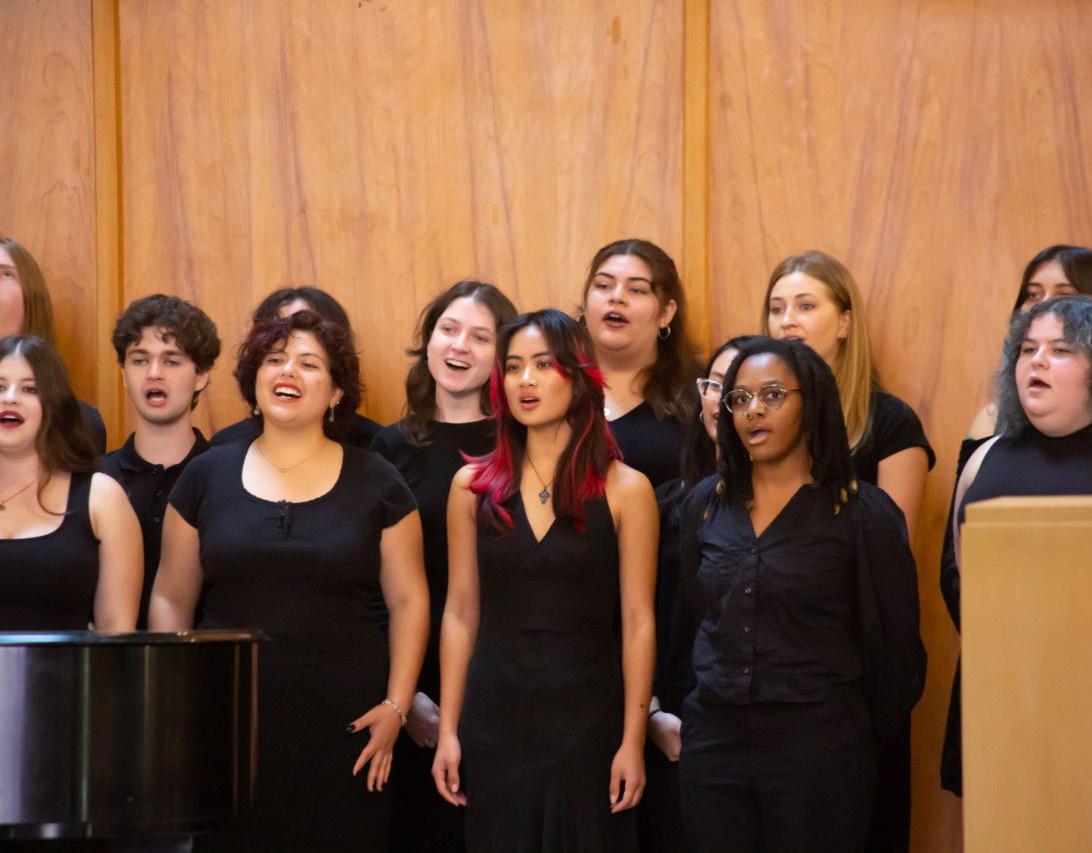
was excited for the opportunity to perform two pieces from her new Holiday Album Once Upon A December, recorded here at her alma mater. Barber expressed gratitude to both Professor Lozano and Artistin-Residence Edward Sywulka for their support, “making a Christmas album has been a lifelong dream” of hers. Though autumn has just begun, Barber brought Christmas early with her performance of the title track “Once Upon a December” and an original song “Sending You a
Little Christmas.”
Before switching up the tune with the college Jazz Ensemble, Professor LeVelle thanked the Artists-in-Residence for giving students the opportunity to work with artists who have professional experience and amazing talent. The Music Department attests, “This type of collaboration provides our student performers with experiential learning opportunities that enrich their musical experience.” In fact, the Jazz Ensemble featured three
guest performers: Ivan Malespine on trombone, alumnus Nicole Vigueria on bass, and Victor Barrientos on drums.
The alumni and students performed the Herbie Hancock classic "Maiden Voyage" followed by the slow and seductive bossa nova sound of Composer Antonio Carlos Jobim’s "Once I Loved." The rendition was exciting and had a strong pulse with Ivan Malespine on trombone.
To close off the set, the College
Choir rushed on stage dressed in beautiful black ensembles accompanied by Dr. Grabarchuk. Grabarchuk thanked guests for coming to support the Whittier Music department and jubilantly announced her current eight month pregnancy.
Afterwards, Dr. Grabarchuk graciously conducted the choir as they performed “Down in the River to Pray”, “Earth Song”, “Seasons of Love” and our College Song “Friends Forever.” With their angelic voices, the choir showed off their immense skill that students have succeeded in attaining so far this semester.
After the performances, guests rushed to the reception, excited to talk about the musical experience. Performers were greeted by their guests who waited in anticipation with flowers and gifts in hand. There was a refreshment and hors d'oeuvre table filled with fruit, hummus, pita chips, and cucumber water for all to enjoy. Next door was a CD booth, where the department offered CDs donated by alumni artists such as Professor Lozano. Merchendise was sold with a suggested donation to help support the Music Department.
This year’s Musicale was a remarkable success for the Whittier College Music Department. If you missed this unforgettable Homecoming performance, you can watch current students shine in the upcoming Musicales on Friday, Nov. 14, and Friday Dec. 5 in the Memorial Chapel.
Paige Meyer-Draffen EDITOR-In-CHIEF
Choice paralysis and the resulting inaction both weigh on American students attempting to find funding for their education. The aid and scholarship options seem endless, but a 1000-word essay outlining the life and struggles of a down-andout college student is too taxing for some students who are struggling to keep pace on their coursework. For them, time and effort is a currency much better spent on laborious classes than long-shot scholarship essays. However, a fellowship opportunity allows for a flexible working timeline with the same financial benefits as other options demanding more of a student’s time.
Take the Barbara Ondrasik (‘57) and David Groce Fellowship for example: an opportunity to research a topic that has occupied your mind with the support of a faculty mentor. This fellowship provides opportunities for students in any field. The research topic can be a personal interest or it can be relative to your major, the choice is yours.
The Ondrasik (‘57) fellowship sponsors students’ research projects with a $5,000 stipend and a $1,500 scholarship upon completion of
the project, a lucrative amount to execute a passion project.
These projects are not restricted to solely writing a research paper.
Students have submitted zines, sculptures, and short films alongside papers as final products. Fellowships like this one (such as the Richard M. Nixon, Cathy Standiford, and Jeffery Lindstrom ‘94 Fellowships) encourage students to engage in internships or to study abroad in order to incorporate the insight those experiences offer into their research. Applications for all Whittier College sponsored fellowships are due on March 6th, 2026.
Fellowships Coordinator Elizabeth Cardenas (née Sanchez) encourages students to dig into a topic that piques their curiosity.
“Maybe in a class you had to skim over a certain topic or event as a contextual piece to a larger concept, but this topic still caught your interest and buzzed in your mind for a little while,” she lights up as she explains how to start an independent research journey. Fellowships are also coveted awards to make an impression in resume writing and offer a taste of the research a student would explore in graduate school. If you are considering entering a graduate program in the humanities, consider
the Mellon Mays Undergraduate Fellowship (MMUF).
The Mellon Mays Undergraduate Fellowship is a nationwide program that aims to uplift individuals with marginalized identities into professorate roles in the field of the humanities. My experience over the last two years in Whittier College’s 16th cohort of the MMUF has cleared the fog that creeps over graduate school admissions and systems. I know the ins and outs of applying to grad school, how to find faculty advisors, and how to find graduate student testimonies.
Students who dig around in JSTOR or the Internet Archive have found their place in MMUF alongside others who have been hoarding books and articles. For ambitious and curious students who want to plan, but don’t know how, this program offers each fellow a total of $17,000 in research stipends over the course of two years in their undergraduate years and personalized resource packages once entering graduate school. The MMUF Fall 2025 cycle application is due on Oct. 27th, and the Spring 2026 cycle is due Mar. 6th.
The College has a concentration in Liberal Arts, but students who are interested in STEM research can still apply to all-inclusive fellowships
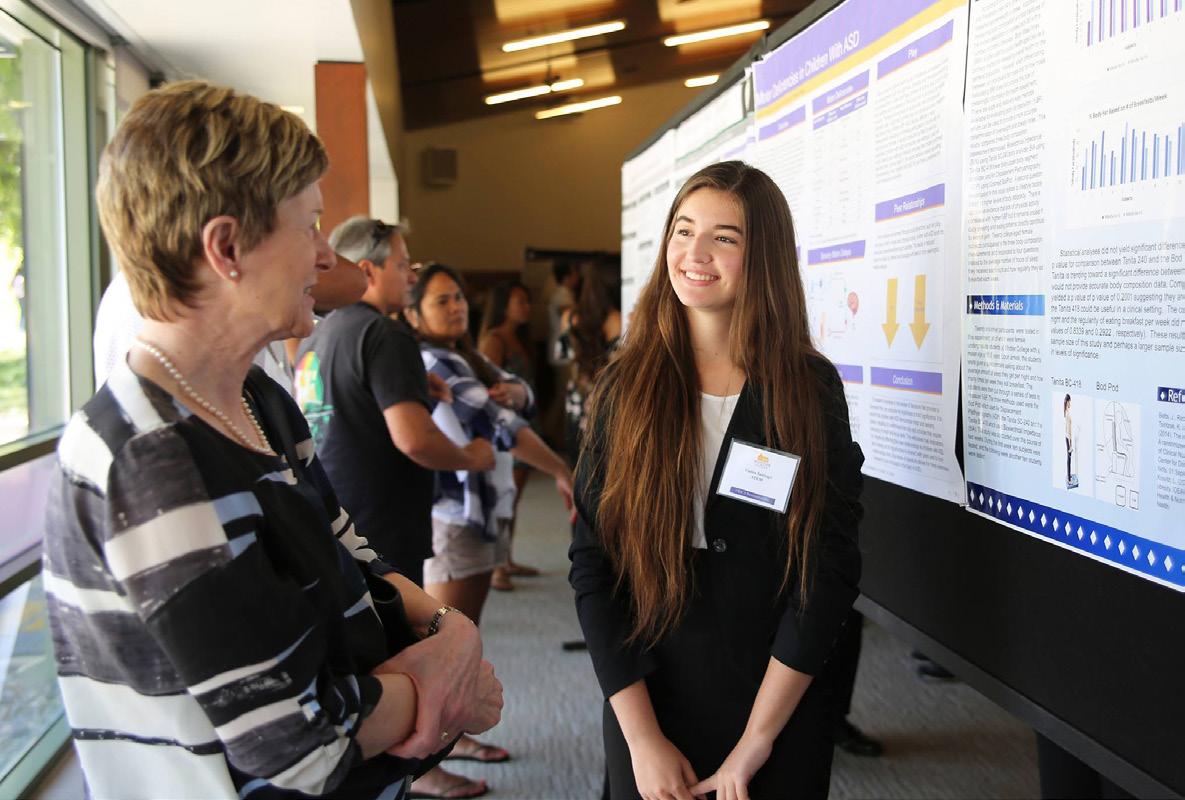
such as the Alianza de Los Amigos Martin Ortiz or Nixon fellowships.
The College offers the Don ‘50 and Virginia Baudrand Fellowship in Chemistry to second and thirdyear Chemistry and Biochemistry majors or minors. This fellowship offers a $3,000 stipend to engage in supervised research in Chemistry.
STEM majors are also encouraged to explore external fellowships, filling the gaps created by the academic priorities of our institution.
Sanchez encourages students to “apply to as many fellowships as [they] would like,” but with the understanding that fellows are permitted one project per
fellowship. Students can be awarded multiple fellowships, but each research project must be different. This can take multiple forms, like a summer fellowship during an internship period and completing another project during the school year. Fellowship awardees must be mindful about how much they take on as the deadlines on these independent projects tend to sneak up on people. Design a timeline with your faculty advisor for each fellowship before starting your project for accountability.
For more information about internal and external fellowships, visit whittier.edu/fellowships.
Nadia Miller CAMPUS LIFE EDITOR
When the fresh air and the crisp wind of fall blows, everything feels like pumpkin spice and sweaters. And as October rolls around, the spooky season begins and excitement for Halloween fights off the sound of Mariah Carey’s “All I Want For Christmas Is You” for one more month. But how much longer will it last? How much longer will Halloween stay as a widelycelebrated, enjoyable holiday for kids and adults to dress up and go trick-or-treating? And how much longer until there are no more trickor-treaters?
Though it may not seem like it, to someone who enjoys Halloween and all the things that the spooky season may bring, celebrating the holiday has become harder each year. Yes, horror movies are still being released and people still decorate their houses, but trickor-treating has definitely become a less celebrated tradition. Most of us enjoyed trick-or-treating or dressing up when we were young, even if we don’t do it anymore. The changes happening around Halloween are not just because our generation grew up.
Today, many parents prefer to take their kids to “trunk-or-treats”
or other festive events held by their schools or cities. The tradition of going door to door seems to be going out of style.
When we were kids, the streets were packed every year with trickor-treaters and practically every house was handing out candy. Now the streets are virtually barren, with only a handful of trick-or-treaters in sight, if at all. What seems like the majority of homes have their outside lights turned off, the typical sign of “no candy here”.
A big part of this shift is due to growing safety concerns. Every year, things seem to get more dangerous and many parents are deciding that the joy of going door-to-door is no longer worth the risk. Parents are scared for their children’s safety, and going outside at night combined with accepting candy from a stranger is something many are growing increasingly wary of.
These concerns have always existed. For example, in my own experience, my parents would check my brother and I’s candy for anything suspicious, even though we lived in a relatively safe neighborhood.
But now these concerns have been rising on a larger scale, with parents believing that taking their children trick-or-treating at all is simply too dangerous. You never know who you might meet, what driver may
not notice your child crossing the road, or what poison could be put in a single piece of candy on one spooky Halloween night.
While safety is a valid concern in this day and age, it also means that the long-standing Halloween tradition of trick-or-treating seems to be going extinct. “Trickor-treating” originated when kids would dress up, go house to house, give a little performance, and yell “trick-or-treat!” Whoever was at the door would give a treat to the children and if there was no treat to be given, then the kids would perform a trick. And over the years, the phrase became something to be said as a fun little thing when kids go up to doors. Now, children are barely going door-to-door at all.
While trick-or-treating may be dying out, there are certainly still aspects of Halloween that are being kept alive. One of them being decorating one’s house for Halloween as they would for other holidays. Some people still go all out, buying the best decorations such as 12 foot skeletons that tower over their house to be enjoyed by the neighborhood. These decorations can also be found inside the home. Many corporations and small businesses also create and
sell Halloween decorations meant to be put up and used each time the spooky season comes around. Personally, I have spent many a dime on the decorations that Michaels offers each year. Many homes still participate in decorating for Halloween, even if it is fewer than when we were children. This is not to say that decorations are the only thing keeping the spirit of Halloween alive. Halloween fairs, pumpkin patches, and costume stores like Spirit Halloween are also helping keep the holiday celebrated and culturally relevant.
While the tradition of trick-ortreating is losing relevance and most parents won’t let their kids out past dark, there are still many things to enjoy about the spirit of Halloween. Decorating one’s space for the

The Poets are tired from midterms. Come back next issue.....if you dare.
holiday is certainly one of them. Fewer may be celebrating, but there are still plenty who dress up for costume parties and for fun on the day of All Hallows’ Eve. Halloween is not dead just yet, and I believe that it can still fight off every early sound of Mariah Carey for at least a couple more years.

Ethan Airada COPY EDITOR
Labubus, Hydroflasks, Fidget spinners, Funko Pops, Shein, iPhones, pumpkin spiced lattes, trends, trends, trends! This is what most of the Global North has been reduced to: the results of a never ending cycle of consumption that decays and turns us into slaves to our own desire in favor of the once intelligent and passionate species we once were. For some, their entire lives are dedicated to consuming their favorite things: our corporate overlords’ products.
Most people consider buying more stuff to be a good thing; it signals that you’re economically secure, and you can express yourself best if you have the most products to do so. The more you have, the more you are. People buy trendy things to feel included in the social status quo.
To be “cool,” you need a new hoodie, the newest iPhone, or maybe those newfangled Labubus you hear so much about on social media. An infamous instance of this phenomenon is the “fast fashion” phenomenon you’ve probably seen on TikTok recently.
“Fast Fashion” is a rather apt name, given how quickly these trends fall out of style; they only last about a week, and they all have ridiculous, long-winded names. For example, “Cottage Core” could be trending, so you buy a vintage floral summer dress, but then “Dark Academia” is suddenly the hottest aesthetic, so you buy buttonup shirts and dark blazers. These two examples have lasted longer online than some other fashion
trends, but what clothing these aesthetics entail changes frequently, artificially creating demand and another week-long cycle of trends, buying, and throwing away. They have no substance, no soul, only a callousness something massproduced could provide.
Trends constantly shift, intersect, and combine. On TikTok, you will often see the creation of hyper-specialized niche fashiongenres that gain attention and popularity, typically given some nonsensical name like “Cottage Core siren sparkly velvet neon firefighter.” These only manage to be successful since they all depend on vastly different demographics, and are often the cheapest options available. You can find most of these trends on Shein, Temu, and Aliexpress. These websites provide consumers with cheaply made and cheaply priced clothing that are near worthless even at the time of purchase.
This is, of course, a business tactic. Products are designed to degrade while being marketed as a necessity or the thing all the “cool kids” are buying, from Hydroflasks, something with actual utility, to fidget spinners, renowned for their distractive capacity. Do you need to fulfill the fashion trends of this week? Well, today is your lucky day! Buy our clothes made of eggshells and throw them away for the next batch! You want to look cool, right? Then buy our stuff, loser! It’s so cheap you won’t even notice you’re already homeless! Rinse and repeat until you have a landfill dedicated to your dead trend.
In fact, according to the Natural Resources Defense Council,
Americans contribute to at least 12% of all global waste products, more than any other nation in the world. So, out of those 239 million tons of annual waste, one can only wonder how many of those tons are made of quickly discarded clothing from Shein.
Speaking of cataclysmic waste, Taylor Swift is one notable celebrity in her carbon-allowance-gluttony era. The renowned pop star released thirty-six variations of her album The Tortured Poets Department with different covers. Countless fans bought every variant, despite there being no substantial difference.
Fan culture has been glorifying overconsumption for a long time now. Buying every single item your favorite celebrity puts out has, over time, become the primary way for one to prove that they are a “real” fan. It’s ridiculous and unsustainable, but it won’t stop so long as the fans’ obsession keeps making their idol money. With the success of the album variants, who’s to say that Swift won’t do it for every single album in the future?
Overconsumption is especially a problem for Gen Z and Gen Alpha, and it poses a threat to all future generations due to the advent of the digital age. Ever since the internet became commonplace, millions have grown up watching YouTube or other short form video sites on digital devices capable of playing six-second videos at rapid intervals. We—you too, the person reading this—have been conditioned and perhaps addicted to screens.
Americans see countless ads every day, practically whenever we use any device. The ease at which businesses have adjusted us to
watching constant commercials is laughable. Gen Z is already addicted to screens, so exposing all of us to different things that might numb the emptiness is just good business. Addicts make excellent customers, after all.
Perhaps it’s like grasping straws to assume that corporations anticipated that this would be a widespread problem, but they sure jumped on the bandwagon. All of these microtrends, the Labubus, and fast fashion? All of that happened on TikTok or Instagram reels, places people express themselves. If enough people have them and like them so much, content creators and even regular social media users will do all the marketing on their own. This culture was not engineered, it created itself!
Gen Z is notorious for having been born and raised with a screen in front of them at all times. It’s our generation that invented “doomscrolling” for hours on end, on a constant search for whatever specks of dopamine our brain
can scrounge from funny internet videos or anything our meager attention spans can handle. Of course businesses would exploit this. People are already on the internet for dozens of hours a week, businesses would be stupid not to advertise on the internet.
And why change this system? All it does is allow the establishment to give us limited-edition distractions for us to chase while they continue to profit off our livelihoods. Despite the real problems presented by overconsumption and how it’s been called to multiple times in the past, it seems like nothing is being done about any of it. Or maybe the massive culture war in the U.S. that seems to just keep going All of this is just to say that each of these issues stem from overconsumption. Pollution, addiction, and depletion, are all symptoms of this system. While we’re still kissing the floor Taylor Swift walks on, these problems are slowly killing us. It’s dystopian, but it’s real.

Madyson Escobedo STAFF WRITER
After Professor Paul Kjellberg's 32 years as an educator at Whittier College, he has decided it is time to retire after this academic year. He has spent more than three decades surrounded by dedicated students and exemplary colleagues who have inspired and motivated him as an educator. Kjellberg will miss the Whittier College hills, scurrying squirrels, and warm community. Kjellberg reflects, “[I] didn’t set out to teach, but once [I] did, I was very glad, because, as a teacher, you get rewarded for making other people's lives better, you know, to contribute to other people's lives."
While teaching the many interpretations of philosophers’ views on human existence, Kjellberg learned more about the human condition through seeing it first-hand, often in his own classroom. Connecting and engaging with his students helped strengthen his teaching technique; so much of his educational philosophy exists outside the simple act of exchanging information.
Students are engaging with the material by observing firsthand with their classmates and processing his teachings collaboratively brings him pride; perfectly reflecting the efficacy of his student-focused teaching style in tandem with the motivation and engagement of his wonderful students. “When we were reading symposiums and classical
philosophy, the groups were really animated. They were really excited, discussing the material, and that really made my heart warm," he reminisced with a smile on his face.
Since becoming a professor in 1993, Kjellberg has noticed how his teaching style evolved over time due to his students' adaptation to his curriculum. When digesting course material in a group setting, the positive impact of idea synthesis influences the class as a community.
Professor Kjellberg teaches a nontraditional way of exploring philosophy, which are doctrine coined by freethinkers and philosophers throughout human history.
Philosophers used the hypotheses from the past as stepping stones in their own nouveau ideas, but this did not always work in the favor of progress. Knowing this, Kjellberg uses the past to learn how philosophical tools are used in the projection of the future. Kjellberg reflects on a conversation he had with a past student who expressed that 19th century philosophy was frightening to him. This opened Kjellberg’s eyes to how his presentation of material in the class was being interpreted in different ways: “to think more about, you know, the experience of students. It's not just about learning, reading these pages, learning these ideas, but about the world." He sees hope and optimism in his students.
When thinking of what advice he would leave behind
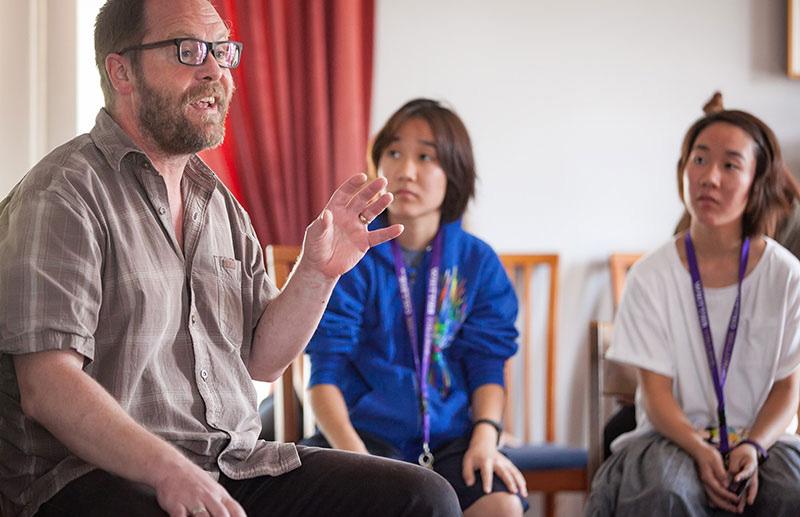
for future professors, Kjellberg reflects on how different the world has become for teachers today. He feels the change has left him isolated among his peers as he can no longer relate to them, seeing as times have changed since he began teaching, which contributed to his decision to retire.
The learning environment at Whittier College has been the primary reason Kjellberg has taught for so long. “It’s the only place [I] would teach." He has explored multiple subjects, a variety of classes, and connected with thousands of students, and all these experiences have brought him to the conclusion that eight

students is the perfect class size for his teachings. The uniquely tightknit, albeit small, community at the College has allowed him the choice of teaching with such a low teacher-to-student ratio that he deeply appreciates. “[I] find a small college experience much more fulfilling,” he says gratefully.
Leaving the classroom will be a unique adjustment for Kjellberg. He will miss his students and the enjoyment of teaching what he loves to new people while being taught a few things himself as well.
Kjellberg enjoys seeing the way Whittier College has kept an unwavering intimate community, embracing the many diverse
groups of students that he gets he pleasure to engage with on campus. While the Kjellberg previously taught at colleges that had more of a competitive academic environment, here at The College, we support each other, a very rare thing to see in higher education. Whittier College will not be the same after Professor Kjellberg's departure. The impact he made on students both in and out of the classroom will be remembered for years to come. It was a privilege to have been educated on his philisophical expertise. We wish him the best in all his future endeavors!

Men’s & Women’s Swimming and Diving vs. Alumni Practice & Gala
Location: Whittier, CA
• All day
• October 17 and 18
Men’s Water Polo vs. PomonaPitzer
Location: Whittier, CA
• 7 p.m.
• October 17
Men’s & Women’s Swimming and Diving @ MPSF Open Water Championship
Location: Long Beach, CA
• 8 a.m.
• October 18
Men’s & Women’s Cross Country @ Highlander Invite
Location: Riverside, CA
• 9 a.m.
• October 18
Men’s Soccer vs. University of Redlands
Location: Whittier, CA
• 7 p.m.
• October 18
Women’s Volleyball @ University of La Verne
Location: La Verne. CA
• 7 p.m.
• October 21
Women’s Soccer vs. Universiy of La Verne
Location: Whittier, CA
• 4 p.m.
• October 22
Men’s Water Polo @ Occidental College
Location: Los Angeles, CA
• 7 p.m.
• October 22
Women’s Volleyball vs. University of Redlands
Location: Redlands, CA
• 7 p.m.
• October 24
Women’s Soccer @ Chapman University
Location: Orange, CA
• 11 a.m.
• October 25
Women’s Volleyball @ Occidental College
Location: Los Angeles, CA
• 4 p.m.
• October 25
Men’s Soccer vs. Chapman
University
Location: Whittier, CA
• 7 p.m.
• October 25
Men’s Water Polo @ Golden West College
Location: Huntington Beach, CA
• 11 a.m.
• October 26
Xochitl Hood STAFF WRITER
The National Basketball Association (NBA) preseason tipped off in early October, offering the first glimpse at new player arrivals and team chemistry across the league. For many franchises, this time of year signals a rare chance to shape their own game schedule and boost viewership. Their games reach every corner of the globe from, Abu Dhabi, United Arab Emirates, San Juan, Puerto Rico, and Macao, China showcasing the NBA’s ever-expanding reach.
Amid the pomp and the circumstance of international hype, Southern California fans center their attention on the everlasting rivalry of Lakers and Clippers and their players whom hold no respect for each other. Is this truly Lebron’s final season in purple and gold with the Los Angeles Lakers? Can the Los Angeles Clippers finally bring home something more than a long flight and short-lived optimism?
Only the upcoming season knows.
During the off-season, the Lakers picked up the defensive menace Marcus Smart, along with Andrey Anyton, providing a much needed upgrade in the post. Lakers’ Head Coach JJ Redick plans for Ayton to fill the Anthony
Davis-sized hole in the lineup for the sake of Luka Doncic and Lebron James. There’s a desperate need for support in the front court, and masters of the pick and roll, late lob, and deceiving eyes can only benefit from an experienced center taking the floor.
Smart’s game completes the Lakers’ puzzle as well. He provides the defensive pressure, which is missing from Luka’s game, while also alleviating the burden of leadership from Lebron. Smart, as a veteran, played an instrumental role in the Boston Celtics’ playoff run in 2022, getting to the big dance but left without hardware.
The Los Angeles Clippers
also made key personnel changes during the off-season. The prodigal son of the captivating “lob city” legend of 2012 to 2017, Chris Paul, returns as a free agent. His uncanny ability to manipulate the floor for a high percentage shot should balance out the detrimental shot selection of starting point guard James Harden’s off nights last season.
John Collins is another player brought in at the small forward, or four spot, given he was formerly a four for the Utah Jazz. He started his career in 2017 with the Atlanta Hawks, where his average points per game doubled from 10 to over 20 in his first three years. This

acquisition clues fans in on Head Coach Tyronn Lue’s plan: keep two-time NBA Finals MVP Kawhi Leonard healthy while not giving up scoring threats on the floor.
These brief updates, among a sea of adjustments, leave more to be seen as to who will have the upper hand. Both teams demonstrate efforts to address weak points and devise schemes preparing for established opponents. In terms of gameplay, they seem to trade punches evenly. But in the domain of public opinion, the Lakers treat the Clippers like their younger brother, the one they dog on in backyard games of one-on-one like it’s nothing.
Although they have never appeared in the finals, the Clippers have not shaken their title of the laughing stock of L.A. proathletics. Whereas the Lakers boast over 15 championships and numerous hall of fame players who remain in the hearts of basketball fans everywhere, forever.
Often, these opposing fates seem to be set in stone before the season even begins as the historically good Lakers stomp the Clippers. Yet, such prophetic predictions made from the comfort of the sidelines of the court will mean little once the ball tips off. In L.A., the feud gains new life at the top of each season, only for the court to decide what comes next— or rather—who is up next?
Paige Meyer-Draffen EDITOR-IN-CHIEF
Atticus Chaidez SPORTS EDITOR
After a three year hiatus, Whittier College is welcoming back Men’s Lacrosse after an incredible fundraising campaign backed by Joe MacCarthy ‘97 and John Damm ‘95. The brand new lacrosse locker room was completed in early October and sits waiting to be filled with sticks, jerseys, gear, and a lively team of players. On Saturday, Oct. 11, the two alumni sat on the sidelines in the barren locker room and watched intently as Head Coach Todd Francis and Assistant Coach Michael Song outlined the Lacrosse program to 33 prospective players.
“We just got our amazing locker room after a month-long build,” Song gestures proudly around the room, “I think that’s a testimony to how motivated this athletic department is to build the program […] While we don’t have an existing team, we are building up the vision for the future of the program.” Similar to the Football program, the College is rebuilding these programs from the ground up. There are six committed players on the lacrosse team, as of Oct. 11, who are practicing and conditioning on the field four days a week.
After the College’s 12 years of dominating in the Western

Collegiate Lacrosse League (WCLL) against other West Coast teams through the ‘80s and ‘90s, the team moved on to the Men’s Collegiate Lacrosse Association (MCLA) to compete in the Southwestern Lacrosse Conference.
The MCLA conference brings bigdog schools such as USC, UCLA, and Chapman University as competitors for the Poets to face in their season in the Spring.
“Winning is something you prepare for,” Song attests. “We are going to prepare you for achievement and success.”
Coach Francis emphasizes the importance of a team having “A little bit of everything.” The recruitment process centered on men of color, many of whom are
a part of the Harlem L.A. program at Compton High School.
Other prospective players come from institutions like Westcliff University, Long Beach City College, and Lakewood High School.
“We follow a multi-step recruitment process that starts with an eyeball test,” Song explains. The coaches review potential players’ footage, clips, and games before reaching out to them with the opportunity to demonstrate their skills with the Poets. The 33 prospective recruits were brought to campus during Homecoming to do just that.
On Sunday, Oct. 12, the prospective recruits took to the turf of Memorial Field to take part in a
showcase and a scrimmage. Here, the prospective players were able to don the colors of Whittier College for the first time—with many to come—on our field.
Song gave a pre-practice speech, offering words of encouragement and advice to the budding team. His booming voice could be heard throughout the entire stadium as his players listened intently. After a short run around the field, switching their lacrosse stick from side to side to practice defending from checks, they soon started some passing drills.
Their play grew into a friendly scrap, rather organically. Their team chemistry was a vision of what the Men’s Lacrosse program was soon to become. Francis had the recruits practice three-on-twos, an offensive opportunity with three attackers against two defenders and the goalie. The players were able to pull off this drill with great success—both the offensive and defensive. Offensive players were able to pick their corners and score, defensive players were able to force an errant pass, while the goalies managed to stuff some shots.
Song gathered the players midway. “We are teammates. We help each other out.” Whether your teammate is being pressured during a game or needs help off the field, Song urges recruits to turn to Quaker values by making sure these players know that they should always be there for each other on—and off—the field.
Jayden Borgna STAFF WRITER
Whittier College has eagerly welcomed back the Poets’ Football Program to campus, but what have they been doing these past two months without any games?
Head Coach Cory White, who has coached at every level of college football, including coaching for the College between 2004 and 2006 as a graduate assistant coach. With this experience, he understands what it takes to build a successful team and is excited to take on this unique opportunity.
“I can almost start a program from scratch, essentially rebuilding the entire program,” explains White. “The challenge with this preparation season is ultimately the plan in creating team culture this semester and setting the standards of expectations for performance.”
White has the team hard at work with weight training and conditioning four days a week and is transitioning the players into field work. The catch with this program is that there are no games to play. They are just training this off-year to get better, faster, and stronger. Essentially, the team has an extra year to grow as players without losing a year of eligibility.
Sean Carter, a first-year from Millikan High School, is excited for this exclusive experience to prioritize training.
“I think that getting the chance to build something new here and having a full year to prepare for next year was the best opportunity for me,” Carter remarks. “It is a little weird not having any games, but I think it is helping us get more familiar with the rhythm of college life.”
While first-years are spending their first year of college in this unusual athletic situation, transfer players on the team are opting for an experience different from what they have had in the past. Thirdyear transfer from the City College of San Francisco, James Mertz, has a positive mindset this year. With his prior collegiate football experience as one of the only third-years on the team, he wants to help his teammates realize their full potential. He understands that having enough leaders and strongminded players will determine the success of the upcoming season.
“It is tough to find motivation since there are no games on Saturday, but I am just taking advantage of my free time to focus on school, getting to know my teammates and coaches, and learning more about football,” Mertz confesses. “There is no pressure of games or injuries, so I am really taking this time to prepare for our next season.”
This program is young, with only a handful of upperclassmen among first-years. White explains
that they currently have 35 players and are hoping to receive 30 transfers by mid-year, and they aim to gain 25 to 30 more first-years next fall. This recruiting process will be significant in the team’s success next year to ensure that any new players maintain the same dedication and willingness. In the meantime, upper-classmen like Mertz understand how significant their role as leaders is.
“There are not a lot of older guys to show how college football runs, so it is up to me and the other transfers to tell the younger guys that this is how college football is,” Mertz says. “They are open to learning and I feel like this group can really build and teach the new transfers and freshmen that will be coming in next year.”
Along with team culture, the Poets are committed to becoming involved in the College’s community, too. White has been determined to involve the team in student life. The players already made a lasting impression by helping students move into their dorms by carrying. Now, the team has weekly meetings with different guest speakers, including members from the Franklin and Orthogonian Societies. Alumni spoke at these meetings to share their post-college and post-football perspectives, and serve as workshop instructors that show the team how to effectively
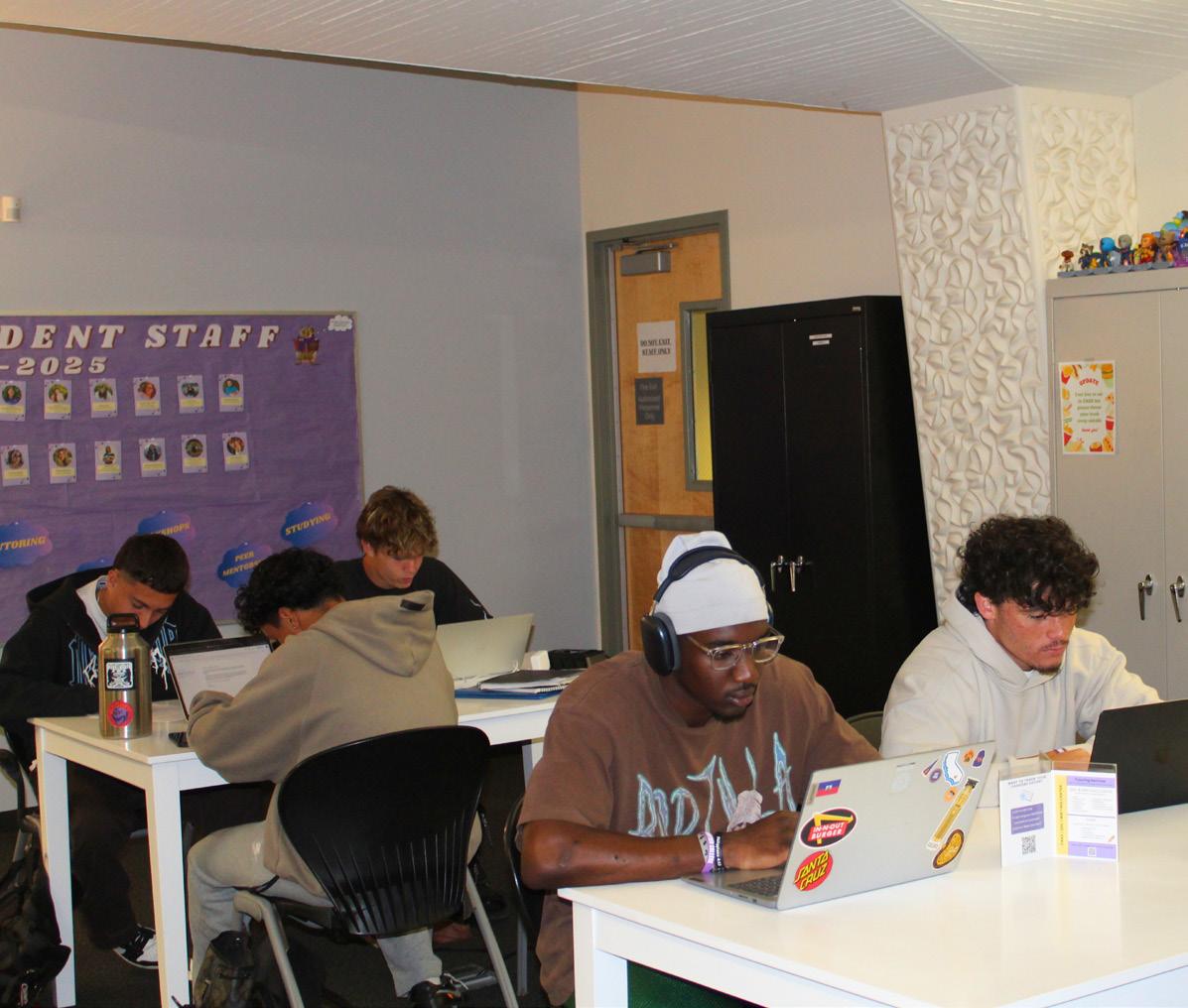
use AI to study. Additionally, the team has mandatory study hall, daily, every morning where they are encouraged to work with the Center of Academic Advising and Success (CAAS). The players feel supported by the tutors, who help with registration, and guidance they receive to work with their professors to stay on track of a minimum 3.0 GPA. The team has also been attending as many sporting events on campus to be supportive of the teams playing.
“There has been a lot of positivity about team culture and getting people to bond with the
community,” says White. “We took them to watch a Division III football game, and we try to get them to go out and support other athletics, emphasizing the fact that football is not everything, and there is more at Whittier College.”
The football team has proved that even in their off-year, they prioritize their involvement in the college community along with their crucial training. The team might be found carrying cement blocks up and down the bleachers, but they’re also sure to be found cheering on a soccer game as soon as practice is over.
Monze Meraz-Lerma SPORTS EDITOR
Whittier College’s Men’s Soccer team flaunts an overall record of 10-1-3 record halfway into their season, already surpassing their wins from last year’s record of 6-7-3. They play in, arguably, the most competitive men’s soccer conference in Division III, demonstrated in each exhilarating game as the Poets fight for every touch. The team’s commitment and depth have pulled them out of the toughest moments on the field.
Captain Rowan Slater, one of three fourth-years on the field, is the only player to have been on the team for all four years. He admits that while his prior years on the team had not produced as much success as this last season, he has watched the program grow every year, culminating in their recordbreaking success. The team this year has the largest returning group of 24 players out of a 38 man team, which Slater acknowledges has been a large factor in their performance. However, he notes that the team’s will to win for each other is what, ultimately, makes them so strong.
“Pretty much every game in SCIAC has been a one-goal game and even in some of our preseason games,” Slater says. “Our ability to pull through and win games, whether it’s our best or worst game, that’s kind of what separates us right now.”
Second-year captain Ben Harrison, also credits the team’s
buy-in to the program’s success and focuses on the team’s strategy as well. Both Slater and Harrison explain that Coach Harwell began drilling in a new system during the spring, making it easy, come fall, when only about 10 new players had to be brought up to speed.
This system involves efficiently working to get the ball to an outside defender, up to a winger, and going from there.
“In the past, we hadn’t really focused on one thing that everybody knew how to do,” Harrison says. “We do a lot of walk-throughs this season, which is the slow stuff and it’s maybe not the fun stuff, it’s boring […] but
just seeing how each piece goes has really given everybody on the team the idea of exactly how we need to play.”
Coach Harwell affirms Slater’s and Harrison’s perspectives, mainly attributing the team’s buy-in—a term that the team constantly uses. The team’s record currently has gained them the first position in the conference, but Harwell argues that even the last ranked team still has the potential to beat them. This precarity makes their team’s mindset that much more significant. He’s proud of the team’s consistent dedication in all aspects of the program, whether that’s team-building exercises or
staying after practice to scrub their soccer balls to make them white for the games.
“This group is handling the pressure really well, almost to the point where it makes me nervous,” Harwell says. “Like, ‘Are you nonchalant or are you just focused?’ I can’t really tell with this group because they’re really calm and really mature.”
This maturity was tested in their single loss against PomonaPitzer on Oct. 4. The devastating 1-2 loss could have halted the momentum of the Poets, but instead, it did quite the opposite. Harrison confesses that the loss stung for about an hour, but the
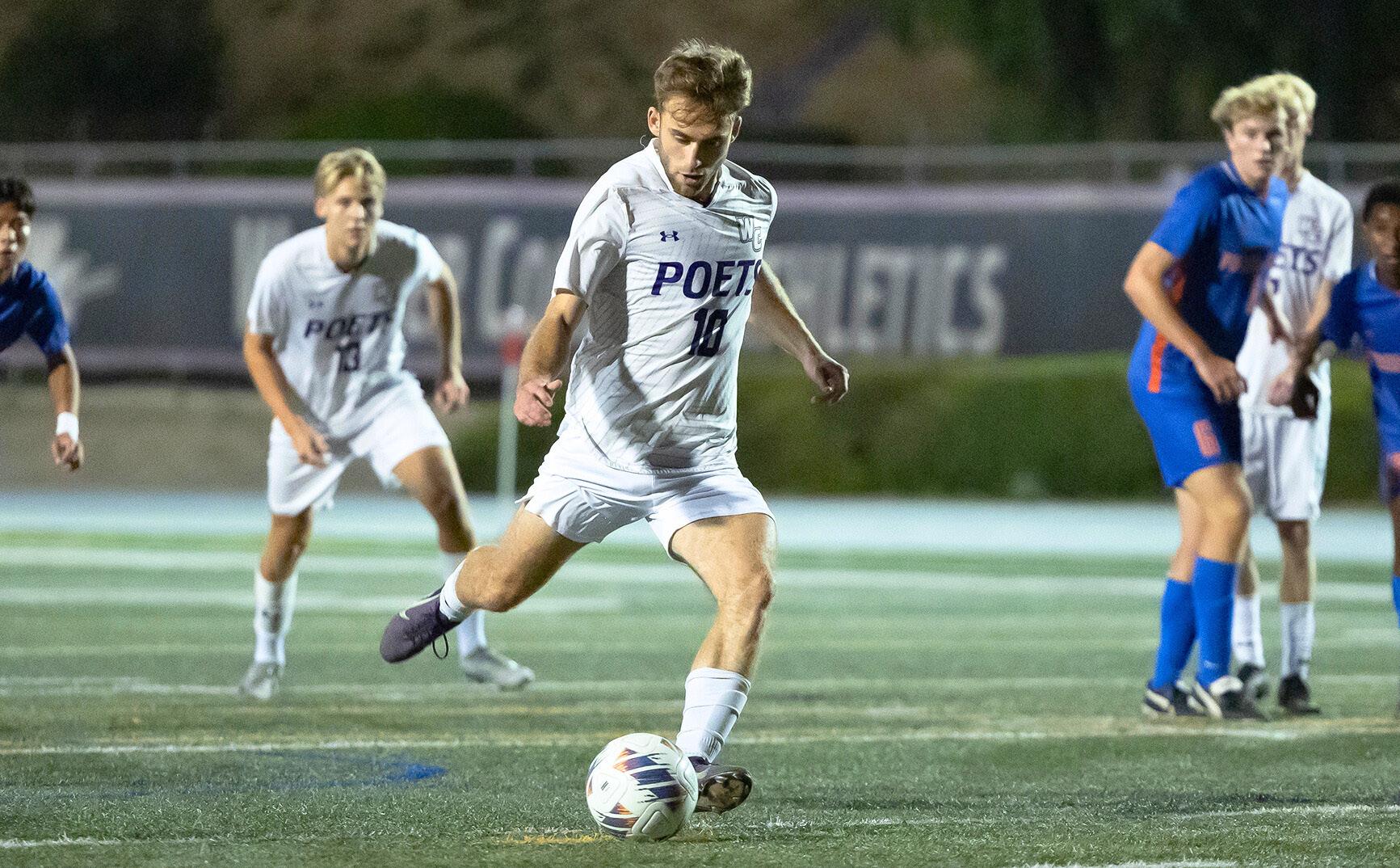
team talked over the weekend and recollected on Monday for a great practice, followed by a great win against Cal Lutheran on Wednesday, and a comeback tie against Redlands on Saturday. The team acknowledged this loss as a learning opportunity.
”Of course I’d love to stay undefeated, but I realized it wasn’t very realistic, and sometimes the loss is good,” Slater says. “Sometimes it kind of kicks us into gear, and I feel like that’s what it did for us.”
With only a handful of SCIAC games left, the team will inevitably have to face-off with Pomona-Pitzer once more in their penultimate match of the season. Nonetheless, the Poets are more than ready for this challenge to play the Sagehens on the opponent’s home field. In fact, they are excited for it.
“It’s going to be electric next time we go back there,” Harrison says. “I think every single guy is just ready to go back. Everyone’s hungry.”
Harwell clarifies that despite being first in conference with the best overall record, they are technically tied with three other teams. Yet, the team is ready for more with the goal of making post-season playoffs for the first time since 2019. The Poets’ plan to continue striving for excellence in everything they do—the team’s motto. With a team full of, “so many good, young human beings,” as Harwell describes, Men’s Soccer is sure to continue making the College proud.
Clover Morales HEAD COPY EDITOR
Want to know what our Head Copy Editor recommends this week? Read on!
Tea:
With the weather finally starting to cool off, tea season is kicking off once more. My personal pick for fall has got to be blueberry pie tea. A nice, warm, cup of tea compliments a good destressing activity like reading, and having a rich, assertive blueberry flavor with hints of sweetness from the notes of apple is the perfect way to wind down after a long day.

Movie:
I find myself revisiting Everything Everywhere All at Once with some out of state friends. It's about a disgruntled mom who feels like she’s losing her purpose in life while balancing a rebellious daughter, a struggling business, and a failing marriage. You can watch it over and over and find something else to appreciate each time.

Music:
buzzG released a new single, “Artifact,” featuring Vocaloid sensation Hatsune Miku. The song uses melancholy lyrics and an electric beat, calling back to past Miku features from the 2010’s. This song has been on loop, and as a huge Miku fan, it's never too late to tune into the blue haired, blue tie wearing idol hiding in your WiFi.

Courtesy of buzzG
Bug:
My favorite bug is the orb weaver spider, found in various gardens, fields, and forests worldwide. Spiders, and arachnids as a whole are so misunderstood, and they're a vital part of the ecosystem. They know how to pay their rent, stay out of the way, and deal with pests. Make sure to thank them!

Ethan Ramillano STAFF WRITER
Since the beginning of his second term, President Donald Trump and his administration have taken an aggressive approach to silencing media critics. Their most recent high-profile target came in September, when late-night talk host Jimmy Kimmel was suspended indefinitely after voicing criticism of the current administration’s use of Charlie Kirk’s assassination as a political rallying point. On Sept. 15, Kimmel remarked, “We hit some new lows over the weekend, with the MAGA gang desperately trying to characterize this kid who murdered Charlie Kirk as anything other than one of them, and doing everything they can to score political points from it.” He followed this with jokes critiquing Trump, frequently mentioning his White House ballroom when asked about his reactions to Kirk’s death: “This is not how an adult grieves the murder of someone he called a friend. This is how a four-year-old mourns a goldfish.”
In response to Kimmel’s trenchant takes during Jimmy Kimmel Live!, Brendan Carr, the Chair of the Federal Communications Commission (FCC) and longterm ally of Trump, switfly condemned Kimmel. According to NPR, in a podcast hosted by conservative influencer Benny Johnson on Sept. 15, Carr warned, “We can do this the easy way or the hard way […] these companies can find ways to change conduct, to take action on Kimmel, or, you know, there’s going to be additional work for the FCC ahead.”
Later that same day, major broadcast corporations, including Sinclair Broadcast Group and Nexstar Media, announced that they would replace the Jimmy Kimmel Live! show. Soon after, ABC, owned by Walt Disney Company and producer of Kimmel’s show, announced that they would be pulling it “indefinitely.”
While the FCC cannot directly suspend a show over its content, it maintains influence through its power to issue broadcasting licenses and review transfers of said licenses for the “public interest.”
This is especially impactful against massive corporations like Disney and Nexstar, which have impending merger deals with other networks and thus require approval from the FCC, according to AP News. In an act of selfpreservation of their high-investment plans, these corporations caved into
following Carr’s demands.
Jimmy Kimmel’s removal brought an immediate wave of backlash against both the Trump administration and Disney, decrying his politically fueled removal as a clear example of government censorship and an unconstitutional violation of free speech. The talk show host received support from a multitude of fellow media personalities, comedians, and even Democratic officials.
In a surprising show of solidarity, even prominent conservatives, such as Candace Owens and Ben Shapiro, criticized the FCC for encouraging Kimmel’s suspension. This included Texan Senator Ted Cruz, who expressed on his podcast, “It might feel good right now to threaten Jimmy Kimmel, yeah, but when [this precedence] is used to silence every conservative in America, we will regret it.”
Alongside public support came protests at Disney’s Burbank headquarters and mass boycotts of their many streaming services, according to The Guardian. Amid rising public backlash, Disney announced on Tuesday, Sept. 22, that after talks with Jimmy Kimmel, the show would return the following day. The return episode greatly boosted the show’s previously declining ratings and viewership, according to TV Insider, made possible due to In his opening monologue, Kimmel clarified that “it was never my intention to make light of the murder of a young man”. He then went on to condemn the Trump administration and ABC affiliates who suspended him, declaring, “That’s not legal. That’s not American. That is unAmerican, and it is so dangerous.”
Jimmy Kimmel was not the first talk-show host to be lawlessly silenced. On July 17, Stephen Colbert announced that The Late Show with Stephen Colbert would end after its final season in May 2026. According to Fortune, Paramount executives stressed in a statement that they greatly appreciated Colbert’s Late Show, and ultimately made a “financial decision against a challenging backdrop in late night”, with no relation to the content of the show.
However, this announcement was made just after Colbert’s previous episode, where he denounced CBS’s parent company, Paramount Global, for settling a $16 million lawsuit with Trump over the allegedly biased editing of a 60 Minutes interview with Kamala Harris. In the wake of Colbert’s announcement, Trump
would celebrate on TruthSocial, “Absolutely love that Colbert got fired. His talent was even less than his ratings. I hear Jimmy Kimmel is next. Has even less talent than Colbert!” Similar to Kimmel’s suspension, it is likely Paramount’s decision was made in preparation for the corporation’s $8 billion purchase of media company Skydance, which will also require approval from Carr’s FCC, according to The Independent Also working with Paramount Global, the satirical cartoon show South Park has received backlash from the Trump administration. Its twentyseventh season premiere on July 23 extensivelymockedthePresident,showing him nude and attempting to sleep with Satan throughout the episode. According to Variety, Assistant Press Secretary Taylor Rogers condemned the show as irrelevant and unoriginal, and chastised, “Just like the creators of South Park, the Left has no authentic or original content, which is why their popularity continues to hit record lows.”
The show also released an episode in August, mocking Charlie Kirk’s sensationalist style of college campus debates. Oddly, these quips received not only compliments but endorsement from Kirk online; he gushed that his depiction was a “badge of honor” and even used his cartoon depiction as a profile picture on social media. But following his assassination a month later, the episode would be pulled from Comedy Central’s schedule on the same day—though it is still available on streaming platforms. Unlike Colbert’s cancellation, South Park creators Trey Parker and Matt Stone have scored lucrative deals with Paramount, protecting them from being axed.
These arrangements include exclusive streaming rights on Paramount+ in exchange for a total of $1.5 billion over five years, in addition to a salary of more than $250 million per year to produce at least 50 new South Park episodes through 2030, according to the Los Angeles Times.
Of course, not all comedians or public entertainers will be winning billion-dollar contracts that protect their livelihood and programs from illegitimate intervention. In a diplomatic atmosphere where the media should be protected by our to Constitutional rights to “freedom of speech, or of the press,” our rights
are instead being slowly made frigid by Trump’s many defamation lawsuits. Allies like Carr are launching equally relentless investigations of broadcast networks and their smaller affiliates to keep them in line (with Fox being the sole exception, according to NPR), the future ahead for political satire and commentary looks grim. In fear of suspensions, legal repercussions, or confrontation from our government, media outlets are likely to enforce more self-censorship and sovereignty over what can be said on television. This can spell an even greater decline for latenight shows in particular, which have been increasingly replaced by social media and soundbites. With Colbert’s show ending next May, and Kimmel’s Disney contract still set to expire by the end of 2026, audiences wonder if corporations will no longer see the worth in keeping late-night TV shows in an ever-expanding digital world. Meanwhile, independent commentary content creators like streamers and podcast hosts are increasingly becoming new figureheads within their own internet spheres, with many becoming successful enough to branch into more traditional mediums. While many of these influencers are freed from the restrictions that hinder television personalities, they are equally beholden to regulate their speech and behavior by corporate sponsors, “terms of service” contracts of platforms like YouTube and TikTok, and especially algorithms, which can greatly impact the audience visibility, growth, and sustainability of any internet personality’s career.
These systems will remain at the whims of executives and tech giants, not so different from the ones who dictate the direction of their networks in a tense political atmosphere.
No matter the medium, what remains universal is the fight to protect our right to free expression, especially in the worst of times.

On July 3, 1985, an Academy Award-winning movie was released to an astounded audience. The movie featured a teenager and his scientist friend who turned his DeLorean into a time-traveling miracle, only possible through science, nuclear energy, and Hollywood magic. Back to the Future has had an undeniable cultural impact.
From thematic writing tropes to remembering how the ‘80s
worked to even comparing fictional realities to our own, these movies are timeless—which is why the first movie is returning to cinemas on its 40th anniversary.
For those who have not seen these movies, Back to the Future follows a teenage boy named Marty McFly (played by Michael J. Fox) travels back in time to the 1950s thanks to his scientist friend Dr. Emmett Brown (played by Christopher Lloyd).
In the process, he meets his parents as teenagers, endangers
his own existence, deals with his father’s bully, invents the skateboard, references things from the future to an unaware cast, and struggles to find a way back to the future without altering anything about the past. The two sequels feature the cast traveling to the distant future of 2015, an alternate timeline, and the Wild West. Each movie has its own charm that allows it to worm its way into the audience’s hearts through themes such as standing up for yourself, knowing when something has to
change, and the idea that “Your future hasn't been written yet. No one's has. Your future is whatever you make it.” All of these films operate under the basic principles of cause and effect, to the point that the movies helped popularize the “butterfly effect” to a non-academic and scientific audience, which states the smallest of actions could have the greatest consequences.
BTF Cont. from pg. 10
The franchise overall has received many accolades, including an Oscar in 1986 for Best Sound Editing, three Saturn awards (Best Actor, Special Effects, and Sci-Fi film), a Hugo award for Best Dramatic Presentation, an animated television series in the 1990s, a few video games (one of which developed by the recently defunct Telltale games), a comic book series by IDW Publishing, and it was eventually considered by many critics and audiences as one of the greatest
science fiction movies of all time. In fact, it wouldn’t be too off the mark to say that people only remember the DeLorean, a real car model, because of these movies.
Back to the Future will play again in theaters starting this Halloween, and the days leading up to the month have two other events in preparation, including a 4K box set release on Oct. 14 and the unofficial “Back to the Future Day” on Oct. 21, the same day the two leading characters traveled to 2015 in Back to the Future II
Universal Studios has also brought
back the franchise to its “Fan Fest Nights” in order to celebrate. Later, on Dec. 5, there will be an anniversary screening, one which Michael J. Fox will attend himself.
As one of the best trilogies of all time, they deserve to be remembered for all they have done, including the simple lessons learned from various shenanigans across the trilogy and the manner in which they show personal growth alongside taking steps toward what someone actually wants from life.
Of course, the car was cool too!
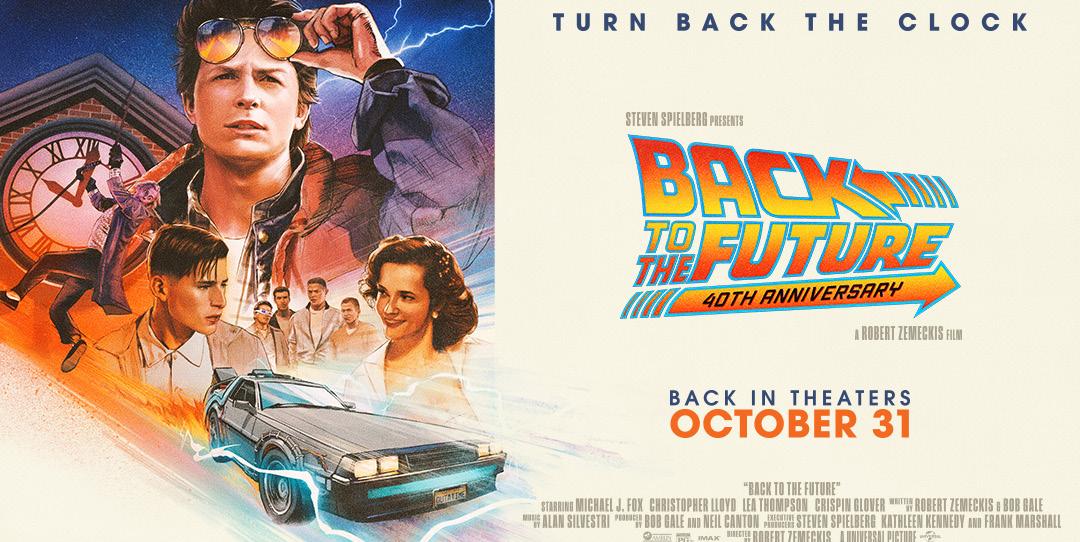
Elias Loya A&E EDITOR
The world’s favorite cartoon dog, his friend Charlie Brown, and the whole Peanuts gang turn 75 years old this year! Snoopy is a widely beloved character, and for great reason: he’s funny, imaginative, and extremely loyal to his friends. Arguably, he’s the most iconic and well-known beagle the world has ever known. But what is art without the artist, and likewise, what is the Peanuts comic without its writer and illustrator, Charles Schulz?
Charles M. Schulz, the creator of Peanuts , was born on Nov. 26, 1922, in Minneapolis, Minnesota. He and his father shared a tradition of reading comic strips each Sunday, and he was particularly enamored with works such as Walt Disney’s Mickey Mouse , E.C. Segar’s Popeye , and Percy Crosby’s Skippy
As a teenager, Schulz submitted his drawing of his family dog, Spike, to be published in Ripley’s Believe It or Not! newspaper. Afterward, he would end up taking a correspondence course in cartooning with Art Instruction, Inc. Schulz continued
to refine his writing and artistic abilities for years. Later, he would go on to pursue a career as a cartoonist upon his return from serving as a staff sergeant with the 20th Armored Division in Europe during World War II.
He began his career by selling cartoons to The Saturday Evening Post , as well as having a weekly panel titled Li’l Folks in the St. Paul Pioneer Press Li’l Folks was the thematic and creative precursor to the comic Schulz eventually became known for.
The Peanuts comic strip began on Oct. 2, 1950, and was originally published in seven newspapers upon its debut: The Washington Post, The Chicago Tribune, The Minneapolis Star Tribune, The Allentown Call-Chronicle, The Bethlehem Globe-Times, The Denver Post, and The Seattle Times . By the time of Schulz’s death on Feb. 13, 2000, Peanuts was reportedly being published in 2600 different newspapers, in 75 countries, and in 21 languages.
At the start of his career, his drawing style included children with large heads, a feature within Li’l Folks and the earliest character designs of Peanuts
As the years went on, Schulz
began to develop his characters, visually and dynamically; the characters became more sentient, his art style gained confidence, the drawings became more expressive, and their personalities and motivations became more fleshed out.
For instance, Charlie Brown gradually became kinder but insecure, and his head became more proportionate to his body; the cartoon boy became more human, more realistic. Snoopy, in the beginning, walked on all fours, but he eventually began to walk on two legs, gained consciousness, an imagination, and became more anthropomorphic overall. Other characters were aged up from toddlers, and given deeper traits, like Schroder’s passion for music and Linus’ attachment to his security blanket. As Schulz’s writing matured, so did his art style.
Why is Peanuts and the work of Charles Schulz so important? The comic allowed its characters (and its readers) to perceive more complex issues and mature concepts, like existentialism, and how to persevere in the face of failure. It offered audiences an escape, a place to find company
and solitude; Peanuts was, in its own way, a grounding experience for the beautifully imperfect lives of its readers. Even after 75 years, we still see the effects of Schulz’s work through widely popular merchandise, plays, several movies, and even through the highly recognizable brand of Peanuts itself.
Next time you want a good laugh, a smirk, a moment to stop and think, or some plain old relatability, read some Peanuts comics! You can find them at GoComics.com.
Happy 75th Anni-Snoopary to the Peanuts !

Atticus Chaidez SPORTS EDITOR
Whether you’re a fan of the music or not, one of the most formative experiences you can go through is attending a punk show. Whether it’s the classic punkrock sound similar to that of the Sex Pistols, Bad Brains, or the Dead Kennedys, or the hardcore bands like Turnstile, Knocked Loose, or Sunami, or even the wacky ska-punk sound, there’s an etiquette to be upheld when attending these shows.
The punk scene isn’t simply another music scene, but a lifestyle. Punk dressing themselves in their personalized battle jackets, stomping around in combat boots, or styling their hair into liberty spikes are ways people express themselves and their anarchist values.
It’s a way for people to say without saying, “This is what I stand and fight for.” Because of their values, it’s important to remember to be respectful when

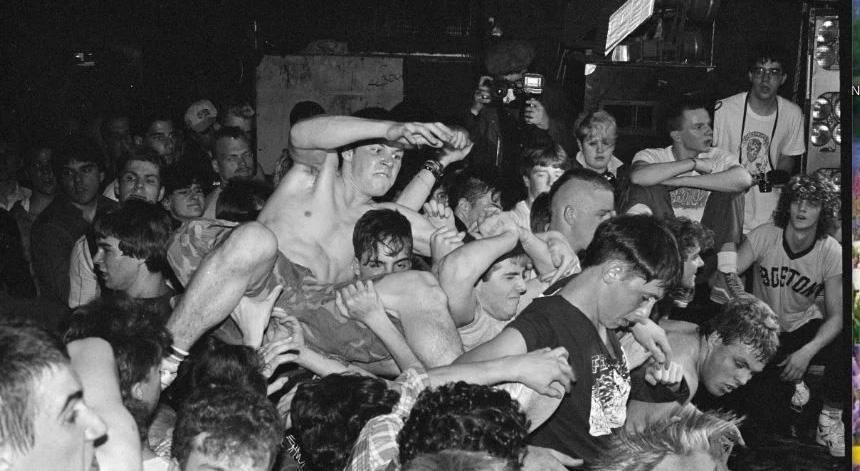
attending punk shows. At the end of the day, a punk show is supposed to be fun, so help do your part in making it fun!
One rule of thumb when it comes to attending a punk show is hygiene, basic hygiene. Showering, wearing deodorant, brushing your teeth, and washing your clothes may not sound like a groundbreaking concept, but to some… it is.
You will get hot and sweaty at these shows, and you may smell
like body odor (B.O.) afterward, so make sure to do your part in limiting the smell to yourself and others. No one likes a stinky person.
Speaking of getting hot and sweaty, moshing is a pretty fast method of becoming just that. two hours of running in a circle pit, two-stepping, skanking (a subjectively more fun way to two-step), wind-milling, will not only get you hot and sweaty, but you will be pushed and shoved
into other people.
At more hardcore shows, you may even get bruised or end up bleeding and, as the genre infers, it is more hardcore. You should always seek medical attention if it’s a serious injury, but you shouldn’t take the aggression and injuries too seriously.
At punk shows, and especially at hardcore shows, it’s angry music made by angry people for angry people, but it’s all love. As conflicting as it sounds, you’re getting pushed, shoved, and hit because you’re considered a part of the “family” so to speak.
Speaking of love in the mosh pit, the most important thing you should keep in mind is when a person falls down, your first priority is to stop and help get them back on their feet. As mentioned before, the pit can be very violent and the last thing people want is to be stepping on someone else.
The same goes for people who look hurt or are trying to get out of the mosh pit. Help them make
their way out by giving a shove in the right direction. Although you may not hear their thanks, they’ll appreciate it.
The last bit of advice I give (but don’t personally follow) is earplugs. Especially at DIY venues, when you’re mere feet away from the band, the music can get very loud.
The last thing you want to deal with years from now is tinnitus that keeps you up all night. Punk is more than just some of the best music you’ll hear and the coolest people you’ll meet, but it’s a way people live, a complete culture. It’s important to respect the culture that decades of people have spent building while also continuing on or even building off of what they built.
At the end of the day, the most important rule of etiquette when it comes to a punk show is to enjoy yourselves. Make friends, jump into the mosh pit, start crowd surfing, safely stage dive, and, of course, have fun.

Elias Loya A&E EDITOR
I remember the first time I saw Turnstile perform. They're a hardcore punk band out of Baltimore, Maryland, and I first saw at Camp Flog Gnaw 2023, a music festival and carnival hosted by Tyler, The Creator. I was nowhere near the mosh pit. I sat on the cracked asphalt of the parking lot at Dodger Stadium, watching the stage in awe of the sheer weight of the energy Turnstile injected into the crowd.
The band was performing songs from their entire discography, including “Real Thing,” from their second album Time & Space, “Fazed Out,” from their first album, Nonstop Feeling, and one of their more well known hits from GLOW ON, “UNDERWATER BOI."
I was unfamiliar with their music at the time, but their performance stuck with me for years; it remains one of my favorite sets I’ve seen at Flog Gnaw (as someone who is going to his third this year). That show inspired me to plunge myself into their third studio album, GLOW ON. While I enjoyed that project, I have gravitated towards other genres in the years since my discovery.
On June 6, Turnstile released their fourth studio album, NEVER ENOUGH, which got me back into their music. I spent hours listening to this album, it occupied my thoughts to the extent that I now own it on cassette and vinyl. Some of my favorite songs off that album include the ambient and mystical title track, “NEVER ENOUGH,” the upbeat and mighty power chords of “SOLE” and “DULL,” and the catchy but raw energy of “BIRDS”.
You can imagine the hysteric thrill buzzing through fans when the band announced the Never Enough Tour, beginning on Sept. 15 in Nashville, Tennessee and ending on Nov. 27 in Madrid, Spain. Luckily, I was able to nab a ticket days before the show on Oct. 4. It was on a cool, overcast day at Exposition Park (an outdoor venue) right next to the L.A. Memorial Coliseum.
My friends and I got in line about thirty minutes before the doors opened,
so we were able to grab merchandise and secure a spot in front of the stage before the opening acts began. We noticed that there was nothing but dirt on the entirety of the venue floor, but we didn’t think much of it at that moment.
The first artist to perform was Jane Remover, who had a fun, autotuned, bassheavy, and dance-oriented set that could be described as hyperpop, with my favorite song of the set, “TURN UP OR DIE."
Next on stage was the Australian hardcore band, Speed, whose heavy riffs and deep vocals really riled up the crowd, empowering them to form three different mosh pits just minutes into the first couple songs.
Then what felt like thirty metric tons of dirt from the floor began flying up in the air, which—when paired with the hundreds of sweaty, adrenaline-fueled fans running around in the circles—created a claustrophobic vacuum that left us struggling to breathe. Nonetheless, I enjoyed the passion they pushed into their set and into the crowd, and I can say they were my favorite opener of the show.
The third opening act was the Australian punk band Amyl and the Sniffers. Their sound had a more classic punk sound, with punchy guitar riffs, screaming vocals, and a stripped-down sound and aesthetic. I loved Amy Taylor’s (singer of Amyl and the Sniffers) vocals, especially during the band’s performance of “Hertz” at the end of their set.
Once the dust finally settled, my friends and I were able to breathe. Suddenly, we were right by the barricade, within feet of the stage. Being that close to the stage was exciting, and I couldn’t wait to see Turnstile up close and personal.
Finally, at around 9:50 p.m., it was time for the headliner. After some ambient keyboard chords played overhead, Turnstile graced the audience with their presence and entered the stage. They began their set with “NEVER ENOUGH.” It’s one thing to know the lyrics, but it’s another to hear everyone in the crowd scream it word-forword.
Chanting with that many people was an angelic experience, to say the least, and
it really set the tone for the rest of their performance. After that first song, they began playing “T.L.C. (TURNSTILE LOVE CONNECTION),” and I was immediately thrown back from my position. Getting really close to the barriers and getting pulled back by the crowd afterwards was a common occurence of this show.
I found no real trouble with this though, as everyone followed basic punk show etiquette and really looked out for each other (for more information, read "Blood, Sweat and Tears" on pg. 11).
Throughout the show, they used a lot of cool and colorful lighting sequences that paired really well with the setlist. Similar to their show at Flog Gnaw, they played songs from earlier albums, while throwing in new material from their latest album.
Turnstile’s setlist packed some serious heat with songs like “NEVER ENOUGH,” “ENDLESS,” “DULL,” “Come Back for More,” and “FLY AGAIN.” However, the best part of the show was, indisputably, the finale. Their final song was “BIRDS,” and I’ll always remember just how thunderous, unrestrained, and cathartic it felt to be jostled around while screaming the lyrics with whatever strength my vocal cords had left. This is honestly one of the best shows I’ve ever been to, and the most fun I’ve ever had in a mosh pit.
Despite being trampled on and ingesting aheinous amount of dust, I found the show to be indellible. There’s just something about being surrounded by thousands of people running around, bumping into one another, crowd surfing, and protecting those who fell or needed a quick second to retie their shoes.
The crowd was so in tune with the energy of Turnstile, and it made me enjoy the experience that much more. It was hard to keep my footing, I was left bruised, and it took two washes to get the dust out of my clothes, but it was so beautifully chaotic, and that’s exactly why I loved it.
The next day I woke up feeling changed by Turnstile's performance; it rekindled a love for being in the moment, and I will forever be thankful for that.




